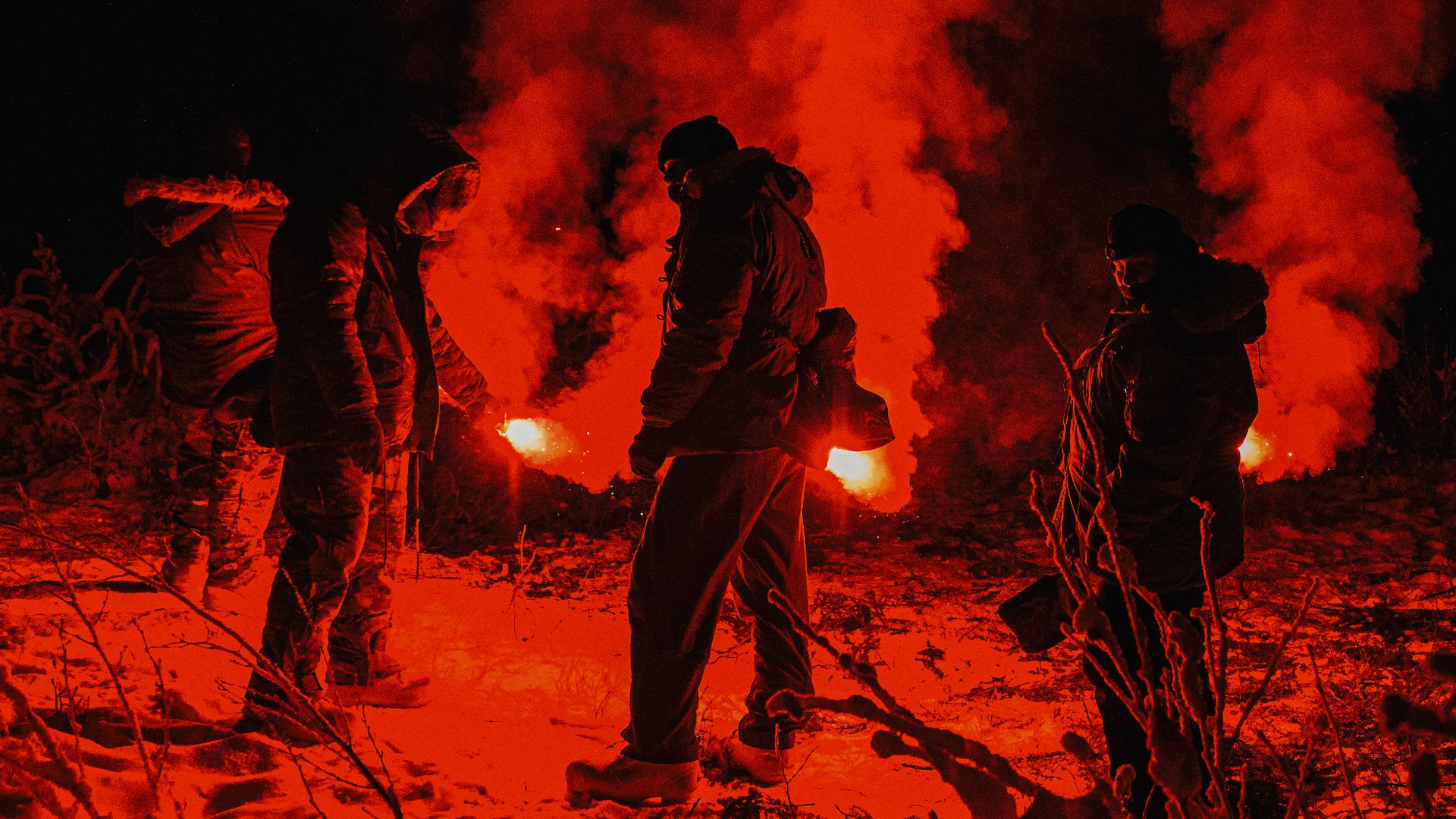
Airmen learn how to use flares as a signaling tool during Arctic Survival School in December 2018 on Eielson Air Force Base, Alaska. US Air Force photo by Senior Airman Sean Carnes.
The US military is built on a pile of unofficial mottos. “If you’re early, you’re on time. If you’re on time, you’re late” and, of course, “Hurry up and wait.” The domino effect of those two particular slogans is that American service members are an hour early for the day’s first task, two hours early for the second, and so on. Above the Arctic Circle, multiply those wait times by about 10 because everything is broken, and the weather is crap. I learned that firsthand in May while embedded with the New York Air National Guard’s 109th Airlift Wing during training in Greenland.
Based out of Stratton Air National Guard Base near Albany, New York, the 109th is home to the only 10 ski-equipped LC-130 cargo planes in the world. Because the fleet is in high demand but has limited numbers, the unit cycles its aging “Skibirds,” ranging in age from 30 to 50 years old, through a high-paced rotation of missions to science stations in Greenland and Antarctica, two of the coldest and most remote places on earth. To prepare for the worst-case scenarios of a crash or emergency landing while overflying the massive, desolate ice sheets that sandwich the globe, the 109th’s airmen undergo four days and three nights of Barren Land Arctic Survival Training, or BLAST, on Greenland’s unforgiving ice cap.
Related: NY’s 109th Airlift Wing: Home of the LC-130, World’s Largest Skiplane

The Milky Way glows through green and purple auroras over the radome at Amundsen-Scott South Pole Station, Antarctica, on July 23, 2022. Every Austral summer, the New York Air National Guard’s 109th Airlift Wing resupplies South Pole Station as well as the National Science Foundation’s other Antarctic research camps. Photo by John-Michael Watson/National Science Foundation.
Arctic ‘Camp Outs’
At first, I thought BLAST was just a military box-checking exercise. The likelihood that the 109th’s aircrews would have to survive a string of sub-zero nights on the ice must be just a farfetched nightmare. While aviation accidents over Greenland aren’t unheard of — a museum on the island country has documented more than 50 crashes, and the Aviation Safety Network has recorded upwards of 150 incidents — they also aren’t an all-the-time occurrence. The last US Air Force plane crash occurred in 1976, when 23 people died in a C-141 StarLifter landing gone wrong. But after boots hit the ground in Greenland, I learned that crashes and emergency landings aren’t the only dangerous outcomes the aircrews prepare for.
“The more likely scenario for us is that there’s bad weather where we’re trying to go, and the weather unexpectedly turned bad where we took off from,” Maj. Nathan King, an LC-130 pilot from the 109th Airlift Wing, tells me.
In less than the blink of an eye, a storm can roll across the ice and blot out the horizon with white-out conditions. Or the cloud ceiling can drop all the way to the ground, obscuring visibility for takeoffs and landings.
“We may just have to land somewhere and wait it out because you can’t just fly around indefinitely,” King says. The aircrews call it “camping out.”
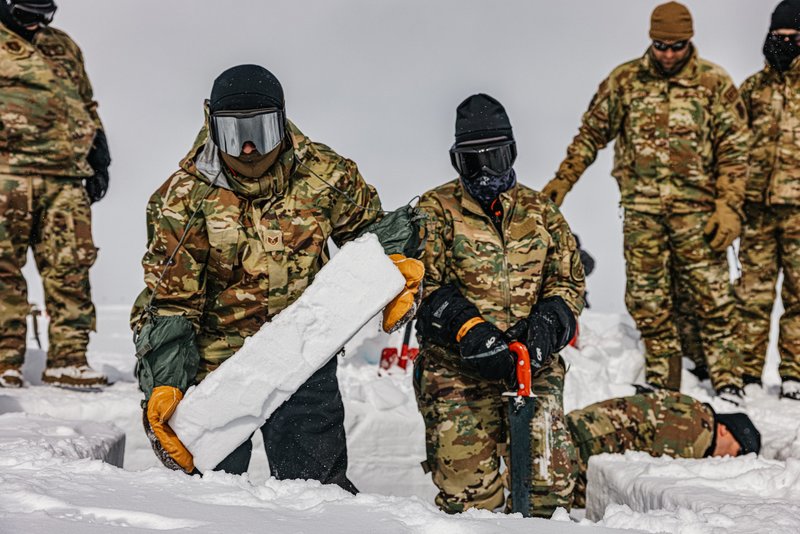
Airmen cut ice blocks to build shelters on the first day of Barren Land Arctic Survival Training in May 2023. US Air National Guard photo by Master Sgt. Jamie Spaulding.
Even though the 109th Airlift Wing has flown “pole to pole” since before the turn of the century, bad polar conditions are still a challenge. And it doesn’t help that their finicky, aging planes require near-constant maintenance.
Related: The US Military in Greenland, America’s Defense Bastion in the High North
A Very Arctic Itinerary
For four straight days, the New York Air National Guard’s 109th Airlift Wing tried flying Coffee or Die onto Greenland’s ice sheet to observe its airmen at BLAST camp. But by the end of the trip, we made it onto the ice for only about five hours. It wasn’t for lack of trying on the part of the 109th; the unit was nothing but persistent.
This is what happened.
Day 1: Today, the airmen were scheduled to start training on the ice cap. The Skibird lined up and prepared for takeoff. Then it veered left to taxi back to maintenance. One engine oil light had blinked on, followed closely by a second. Luckily for us, a maintenance crew serviced both engines within 20 minutes. Take two. This time, the Skibird successfully took off for the ice cap. But after an hour’s flight, we started circling. Uh-oh. Apparently, a flock of stubborn birds wouldn’t leave the snow runway. The pilots radioed the ground crew, asking them to clear the birds, but they couldn’t establish communication. Roughly half an hour later, the birds flew away, but at that point, the weather had turned bad. And a crew member’s shift was about to lapse. We flew back to town. We would have to try again tomorrow. The four-day, three-night course just shortened to three days and two nights.
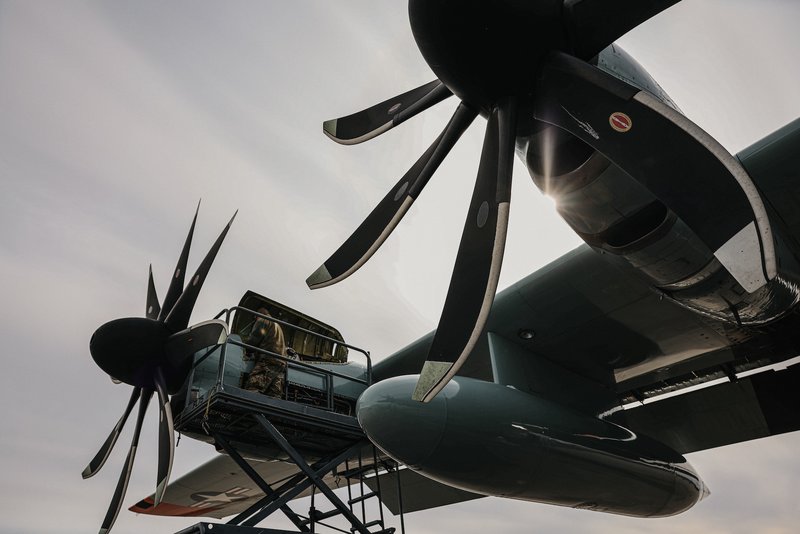
A 109th Airlift Wing maintainer works on an LC-130 engine on May 15, 2023. Every year, the 109th flies to Greenland to train in the Arctic and provide airlift support for the National Science Foundation’s remote research camps. US Air National Guard photo by Staff Sgt. Madison Scaringe.
Day 2: Today goes better, but nothing goes perfectly in the Arctic. The 20 BLAST students loaded onto the LC-130, and the plane took off. So far, so good, but visibility at our destination was poor. The pilots made one failed approach before landing on a second try. Thank God, it wasn’t a repeat of yesterday. Against the backdrop of white nothingness, we watched the students make water from snow and cut ice block after ice block for shelter. Things were looking up. However, visibility was still poor when the LC-130 returned for us — the nonstudents — about five hours later. After a failed takeoff attempt, try number two had us flying for town, ready to return the following day.
Day 3: By now, I thought I had seen everything. I was wrong. I had seen nothing. Day 3 was the day that all three of the LC-130s in Greenland decided to break. The entire day, we waited, hoping to make it back to the ice sheet. But hope didn’t get us anywhere. Not only did we not return to BLAST camp, but the 109th’s aircrews did not make any of their other scheduled flights either.
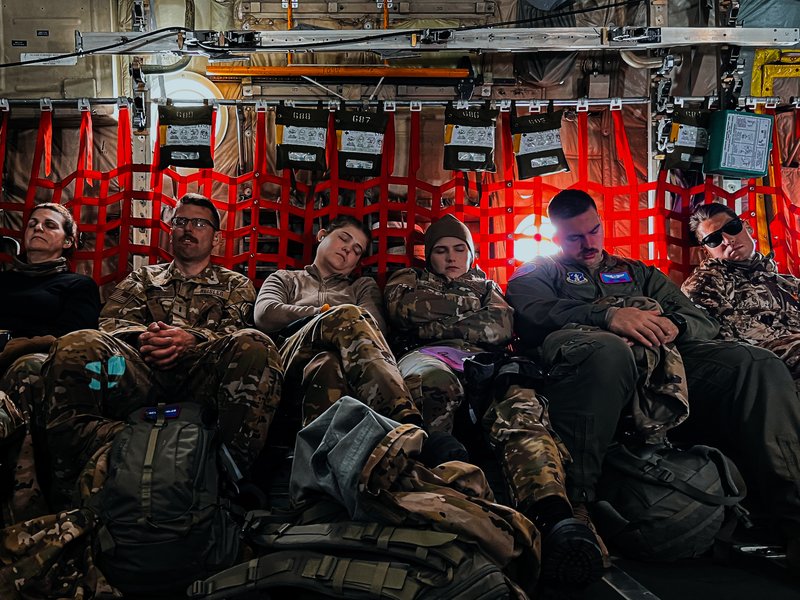
After three days and two nights on the ice sheet, the airmen who just endured Barren Land Arctic Survival Training pass out on their flight back to Kangerlussuaq, Greenland, in May 2023. Photo by Jenna Biter/Coffee or Die.
Day 4: I blinked, and it was over. It was already time to pick up the BLAST students and drop off another class. According to the ground crew, the snow at camp was particularly soft, so the pilots loaded the LC-130 with JATO rockets in case the plane needed an extra boost to leave the melty runway. The last thing the cadre wanted was two classes stuck on the ice cap with only enough instructors and supplies for one.
Rockets can help with takeoff but can’t help with landing. After the hour-long flight, we couldn’t land, not right away. The clouds hung low, and wind whipped across the ice sheet. We burned holes in the sky for almost an hour before the weather cleared enough for us to land. After about 15 minutes on the ice, the students traded places. It was time to go. We wouldn’t be back to the ice sheet again. We sped down the runway, but the plane couldn’t get enough power to take off. We tried again. With the second attempt, there was a boom. The rockets engaged and boosted us into the air. The students clapped. They were going home.
As it turns out, Murphy’s Law and Mother Nature always get a vote north of the Arctic Circle. Fifty-year-old planes regularly break, and the weather on a 660,000-square-mile ice sheet is rarely predictable. The more I think about it, the more I realize just how necessary the 109th Airlift Wing’s Barren Land Arctic Survival Training is.
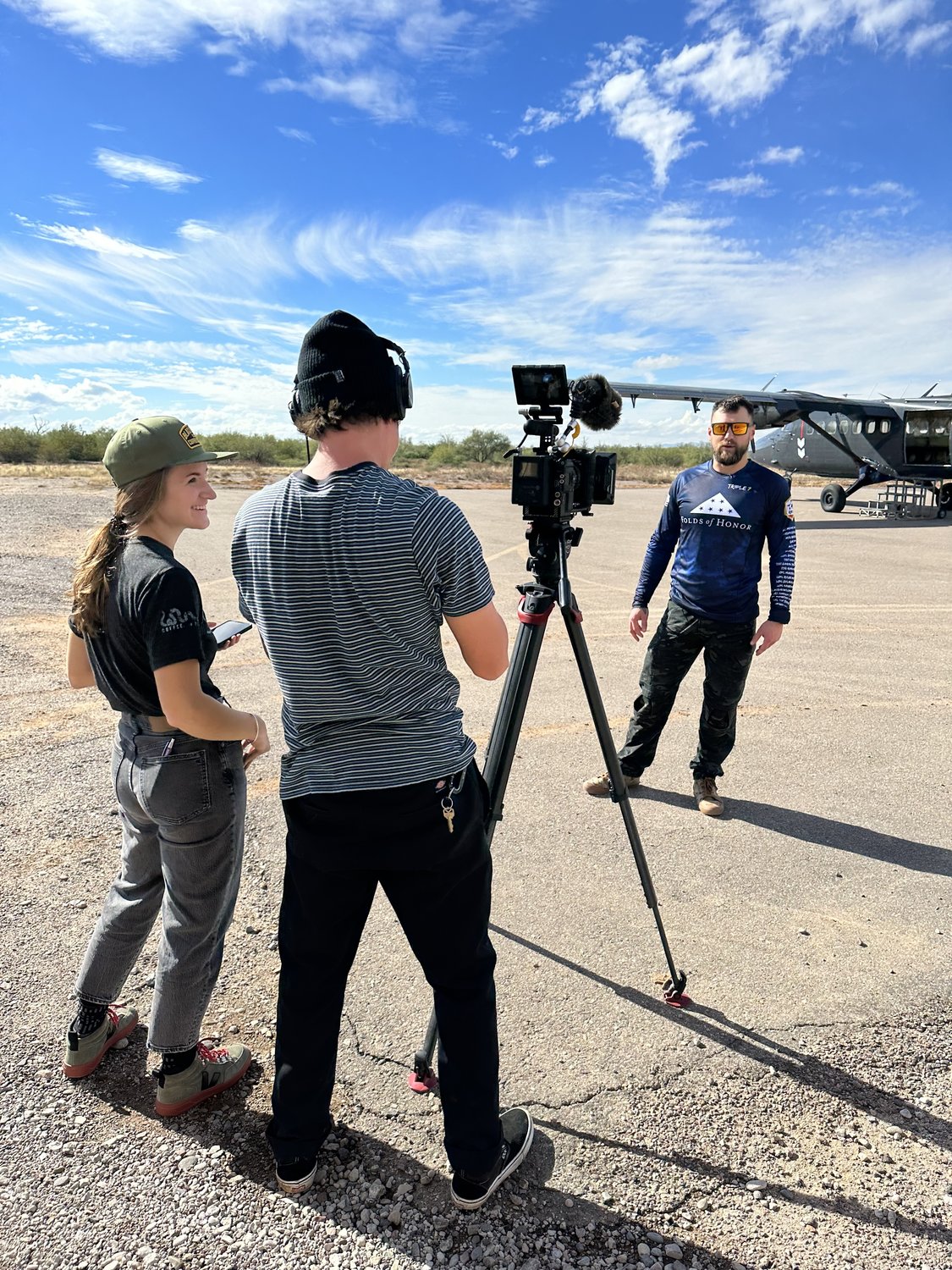
Jenna Biter is a staff writer at Coffee or Die Magazine. She has a master’s degree in national security and is a Russian language student. When she’s not writing, Jenna can be found reading classics, running, or learning new things, like the constellations in the night sky. Her husband is on active duty in the US military. Know a good story about national security or the military? Email Jenna.
BRCC and Bad Moon Print Press team up for an exclusive, limited-edition T-shirt design!
BRCC partners with Team Room Design for an exclusive T-shirt release!
Thirty Seconds Out has partnered with BRCC for an exclusive shirt design invoking the God of Winter.
Lucas O'Hara of Grizzly Forge has teamed up with BRCC for a badass, exclusive Shirt Club T-shirt design featuring his most popular knife and tiomahawk.
Coffee or Die sits down with one of the graphic designers behind Black Rifle Coffee's signature look and vibe.
Biden will award the Medal of Honor to a Vietnam War Army helicopter pilot who risked his life to save a reconnaissance team from almost certain death.
Ever wonder how much Jack Mandaville would f*ck sh*t up if he went back in time? The American Revolution didn't even see him coming.
A nearly 200-year-old West Point time capsule that at first appeared to yield little more than dust contains hidden treasure, the US Military Academy said.












